The Near East Side is a neighborhood located near downtown Columbus, Ohio, made up of several neighborhoods: Mount Vernon, King-Lincoln Bronzeville, Eastgate, Franklin Park, Nelson Park, Olde Towne East, and Woodland Park.

The Brittany Apartment Building is a historic apartment building in downtown Cincinnati, Ohio, United States. A Queen Anne structure constructed in 1885, it is a six-story rectangular structure with a flat roof, built with brick walls and elements of wood and sandstone. It was built by the firm of Thomas Emery's Sons, Cincinnati's leading real estate developers during the 1880s. It is one of four large apartment complexes erected by the Emerys during the 1880s; only the Brittany and the Lombardy Apartment Buildings have endured to the present day. Both the Lombardy and the Brittany were built in 1885 according to designs by Samuel Hannaford; at that time, his independent architectural practice was gaining great prominence in the Cincinnati metropolitan area.
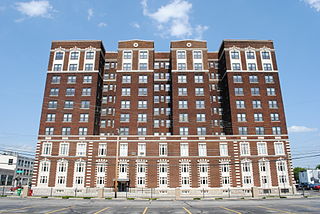
The Seneca, formerly known as the Seneca Hotel, is a 10-story apartment complex and former hotel in the Discovery District of downtown Columbus, Ohio. The brick building was designed by architects Frank Packard and David Riebel & Sons and built in 1917, in a prominent location near Franklin County Memorial Hall, where conventions were held. A four-story wing was built on the hotel's east side in 1924. The hotel closed in the mid-20th century, and it held the Nationwide Beauty Academy from 1960 to 1974. Dormitories held female students for Nationwide and about six other public and private schools downtown. The Seneca became home to the Ohio Environmental Protection Agency from 1976 to 1987. The building was added to the National Register of Historic Places in 1983 and the Columbus Register of Historic Properties in 1991. In 1988, the building became vacant, and remained that way until 2005.
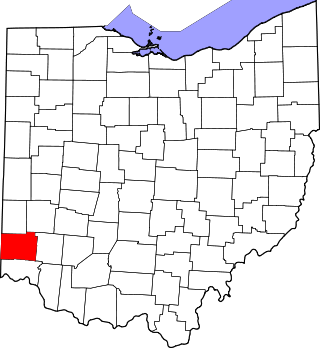
This is a list of the National Register of Historic Places listings in Butler County, Ohio.

The Martin Luther King Jr. Performing and Cultural Arts Complex is a historic building in the King-Lincoln Bronzeville neighborhood of Columbus, Ohio. It was built in 1925 as the Pythian Temple and James Pythian Theater, and was added to the National Register of Historic Places and Columbus Register of Historic Properties in 1983. The building was renovated into the King Arts Complex in 1987, and was vacated in 2019. Community leaders restored the building's use as an arts center in 2021.

The Montgomery Ward Company Complex is the former national headquarters of Montgomery Ward, the United States' oldest mail order firm. The property is located along the North Branch of the Chicago River at 618 W. Chicago Avenue in Near North Side, Chicago, Illinois. It was listed on the National Register of Historic Places and as a National Historic Landmark on June 2, 1978.

The United States Post Office and Courthouse is a historic building in Downtown Columbus, Ohio. The structure was built from 1884 to 1887 as the city's main post office. The building also served as a courthouse of the United States District Court for the Southern District of Ohio from its completion in 1887 until 1934, when the court moved to the Joseph P. Kinneary United States Courthouse. The building was tripled in size from 1907 to 1912, and was rehabilitated for use as the Bricker & Eckler law offices in 1986, and today houses the same law firm.

The Atlas Building, originally the Columbus Savings & Trust Building, is a high-rise building in Downtown Columbus, Ohio, built in 1905 and designed by Frank Packard. It was added to the National Register of Historic Places in 1977. The building has seen two major renovations, in 1982 and 2014.
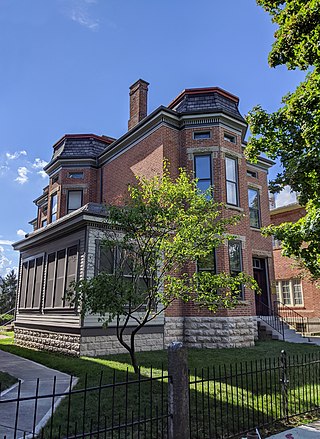
The Columbus Landmarks Foundation, known as Columbus Landmarks, is a nonprofit historic preservation organization in Columbus, Ohio. The foundation is best-known for its list of endangered sites in the city and its annual design award, given to buildings, landscapes, and other sites created or renovated in Columbus. It was established in 1977, following the demolition of the city's historic Union Station. It is headquartered at 57 Jefferson Avenue, a contributing structure in the Jefferson Avenue Historic District in Downtown Columbus.
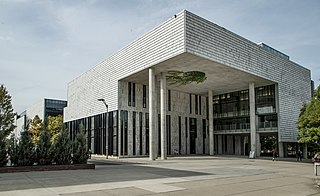
The architecture of Columbus, Ohio is represented by numerous notable architects' works, individually notable buildings, and a wide range of styles. Yost & Packard, the most prolific architects for much of the city's history, gave the city much of its eclectic and playful designs at a time when architecture tended to be busy and vibrant.

The Ohio Baptist General Association Headquarters is a historic building in the Woodland Park neighborhood of Columbus, Ohio. It was listed on the Columbus Register of Historic Properties in 2019 and the National Register of Historic Places in 2020. The house was built for Jerimiah Foley from 1904 to 1905. It remained residential until 1954, when the Ohio Baptist General Association (OBGA) purchased it to act as its headquarters. The association dedicated the building in October 1957, and fully converted it to offices by 1958. The OBGA ceased operations in the building in 1996, and is partnering in a restoration effort to preserve its historic features. The building, listed on the 2018 Columbus Landmarks' "Most Endangered" register, is planned to gain residential units as well as return to acting as the organization's headquarters.

The Hartman Hotel is an condominium complex and former hotel and office building in Downtown Columbus, Ohio. The building was completed in 1898 and was listed on the National Register of Historic Places in 2018.

The Avery Pontiac Building is a historic building in Columbus, Ohio. It is located in Columbus's Near East Side, roughly between the Franklin Park and Olde Towne East neighborhoods. The building was added to the Columbus Near East Side District in 1978. It was individually listed on the Columbus Register of Historic Properties in 1984.

The Trolley District is a mixed-use complex in Columbus, Ohio. The three-acre (1.2 ha) site houses the East Market, a public market and food hall, as well as two bars, and will also include restaurants, a brewery, and event space, with neighboring apartments. The property is located in the city's Franklin Park neighborhood and is a contributing part of the Columbus Near East Side District, listed on the National Register of Historic Places.

The former Columbus Railway, Power & Light office is a historic building in the Milo-Grogan neighborhood of Columbus, Ohio. The two-story brick structure was designed by Yost & Packard and built in the 1890s as a transportation company office. The property was part of a complex of buildings, including a power plant, streetcar barn, and inspection shop. The office building, the only remaining portion of the property, was utilized as a transit office into the 1980s, and has remained vacant since then. Amid deterioration and lack of redevelopment, the site has been on Columbus Landmarks' list of endangered sites since 2014.

Poindexter Village was a historic public housing complex in the King-Lincoln Bronzeville neighborhood of Columbus, Ohio. Today, the remaining two buildings are set to become the Poindexter Village Museum and Cultural Center.

The Sofia is a condominium building at the corner of Columbus Avenue and 61st Street on the Upper West Side of Manhattan in New York City. It was constructed from 1929 to 1930 and was designed by the firm of Jardine, Hill & Murdock in the Art Deco style for Kent Automatic Garages. The Sofia is 27 stories tall; the first nine stories above the ground level are used as offices, while the top 17 stories contain residential condominiums. The building is a New York City designated landmark and on the National Register of Historic Places.
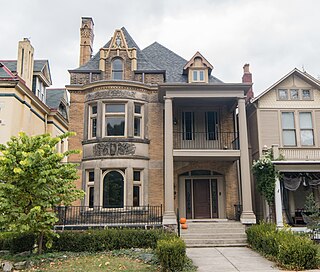
The Joseph Warren Yost House is a historic house in Columbus, Ohio. It was added to the Columbus Near East Side District in 1978, and the Bryden Road District in 1990.

120 S. Central Avenue is a former school building in the Franklinton neighborhood of Columbus, Ohio. The building was built for the West High School, and later served as Starling Middle School and Starling Elementary School. The building was added to the National Register of Historic Places and Columbus Register of Historic Properties in 2022.



















